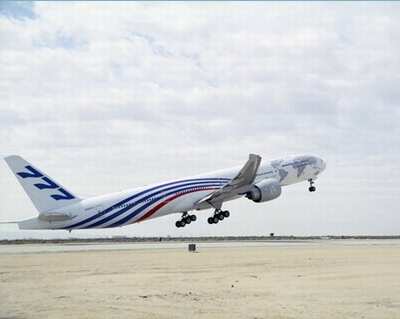Boeing 777-300ER Sets Takeoff Weight Record During Testing
 The Boeing 777-300ER (Extended Range), the newest
in the 777 family, recently set a maximum-takeoff weight record of
774,600 pounds – the heaviest takeoff ever for a
twin-engine airplane. That takeoff occurred May 19 during U.S.
Federal Aviation Administration certification testing at Edwards
Air Force Base. Boeing 777 Chief Test Pilot Frank Santoni and FAA
Certification Pilot Eugene Arnold were at the controls.
The Boeing 777-300ER (Extended Range), the newest
in the 777 family, recently set a maximum-takeoff weight record of
774,600 pounds – the heaviest takeoff ever for a
twin-engine airplane. That takeoff occurred May 19 during U.S.
Federal Aviation Administration certification testing at Edwards
Air Force Base. Boeing 777 Chief Test Pilot Frank Santoni and FAA
Certification Pilot Eugene Arnold were at the controls.
Because the airplane’s takeoff weight exceeded the planned
759,600-pound certification weight, restrictions were applied to
the airplane’s center of gravity locations. Ground and air
maneuvers were monitored during takeoff, flight and landing to
ensure airplane structural loads were not excessive.

"The higher-than-normal takeoff allowed us to gather data for a
number of takeoff conditions without refueling," said Lars
Andersen, Boeing 777 Longer Range program manager. The GE90-115B,
the world’s most powerful jet engine, is the
777-300ER’s power plant. The GE Aircraft Engines product,
which generates 115,000 pounds of thrust, also will be on the
ultra-long-range 777-200LR (Longer Range) that’s now in
development.
The 777-300ER takeoff broke a record held by the 777-300. That
airplane reached 678,400 pounds during flight testing in 1997. Two
777-300ER airplanes currently are being put through 1,600 hours of
flight-testing. So far the crews have evaluated takeoff, landing,
handling characteristics and fuel-mileage tests, recording results
that have exceeded expectations.
For example, fuel mileage tests show a 1 percent improvement in
fuel efficiency over original predictions. Such improvement
can:
- Reduce by 106,400 gallons annually the amount of fuel one
airplane uses. That’s enough to power 130 cars for one
year.
- Reduce by nearly 2.5 million pounds carbon dioxide (CO2)
emitted into the environment.
Increase the airplane’s range by 75 nautical miles to
7,495 nautical miles.
- Increase the airplane’s payload by 2,400
pounds – passengers or cargo – on a 7,000 nautical
mile flight.

"Our team is excited about the outcome of these tests," Andersen
said. "This is just another example of how Boeing meets or exceeds
performance predictions when bringing a new airplane to market.
This is a testimony to our world-class engineers, and the great
performance of the GE90-115B and the GE90 team."
Certification of the 777-300ER by U.S. and European regulatory
authorities is slated for early next year. The first 777-300ER will
be delivered next April to International Lease Finance
Corp.’s customer, Air France. The 777 family has captured
nearly 70 percent of the market since it was launched in October
1990. More than 30 customers have ordered 619 777s, including 61
Longer-Range 777s ordered by seven customers: Air France, All
Nippon Airways, EVA Airways, GE Capital Aviation Services,
International Lease Finance Corp., Japan Airlines and Pakistan
International Airlines.
 Aero-TV: DeltaHawks Diesel Power Steps Into the Spotlight
Aero-TV: DeltaHawks Diesel Power Steps Into the Spotlight NTSB Prelim: Mooney Aircraft Corp. M20K
NTSB Prelim: Mooney Aircraft Corp. M20K ANN FAQ: Turn On Post Notifications
ANN FAQ: Turn On Post Notifications ANN's Daily Aero-Linx (12.20.25)
ANN's Daily Aero-Linx (12.20.25) Aero-News: Quote of the Day (12.20.25)
Aero-News: Quote of the Day (12.20.25)





